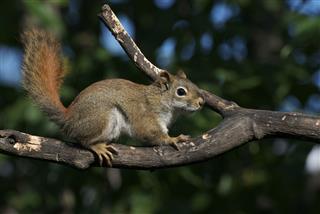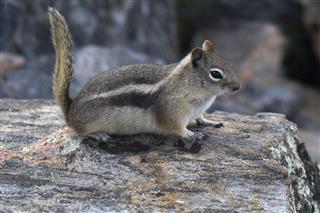
Squirrels are busy little rodents, always gathering food or running around. Do they ever rest or sleep? Of course they do! Check out the sleeping and nesting habits of squirrels in this AnimalSake write-up.
Tail Tale!
● The bushy tail, almost equal in size to its body, not only helps the squirrel to maintain balance when leaping from tree to tree, but also serves as a soft and warm natural blanket.
● They also use their tail to communicate with each other. Notice the position of the tail when a squirrel is alarmed or when it is just playing around; you will notice the difference.
Whenever squirrels are mentioned, squirrels scampering and running around, gathering food, or leaping from tree to tree, come to mind. Well, all that work sure must exhaust them, and these little fellas do need their dose of sleep. In fact, they do sleep a lot; squirrels spend around 60% of their total time sleeping! On an average, squirrels spend 14.9 hours sleeping each day.
The exact sleeping habits and nesting places vary slightly according to the different types of squirrels. There are three main types of squirrels―flying, ground, and tree squirrels. Ground squirrels are found all over the world. Gray squirrels and red squirrels are types of tree squirrels. Gray squirrels are native to North America, whereas red squirrels are commonly found in Europe. The most distinctive feature of gray squirrels is their big eyes. Red squirrels are slightly smaller than the gray ones and have a reddish-brown coat. Another type of squirrel commonly found in America is the fox squirrel. There can be variations in color as squirrels usually shed their coat during summers. Let us now try to understand how long, where, and when do squirrels sleep.
Flying Squirrels
Flying squirrels spend most of their time in trees. Thus, their nest is very important for them, and most squirrels have more than one nest. They sleep during the day and get out to forage or play at night. They don’t really fly, but have web-like flaps of skin attached to their sides. These flaps help them glide from tree to tree. Flying squirrels live in tree dens, and make nests during summers in which they sleep. Their dens are lined with leaves or moss. They can also live in attics or tree houses. During winters, more than 10 squirrels can live together. This provides them with added insulation when sleeping. Sometimes, flying squirrels can be seen napping on tree branches as well.
Tree Squirrels
Gray, fox, and red squirrels sleep in their nests. Their nest is called a drey. Dreys are usually made with leaves, twigs, mosses, or branches. These are made between forks in branches of trees, in attics, or along a wall. Both males and females, along with their young ones, take part in nest building. Squirrels sleep at night, and sometimes in the afternoons, when they are not running around. They love the sun, and spend more time in the open during summers. Red squirrels usually make their nests in conifer forests as they love pine cone. They sleep and take care of their young ones in these nests.
Ground Squirrels
Ground squirrels spend most of their time on the ground. They even sleep in burrows. In the Northern areas, due to harsh winters, they hibernate through the winter. They only wake up for a little period to forage for food and then go back to sleep. This period of around five to six months is very restful for the squirrels. Squirrels in deserts and extremely hot areas, estivate during summers.
Baby Squirrels
Newborn squirrels take around eight weeks to open their eyes. They share a nest with their mothers during this period. Once they mature, they live in their own nest. Tree-dwelling squirrels mature faster than the flying squirrel; they are fully grown by 10 months, whereas flying squirrels take around 18 months. Once, they are mature, they make their own nest and have their own place to sleep. They may share their dwelling with a fellow squirrels during winter.
Foraging for food, playing around with mates, and storing food for winters, are their main activities; rest of the time is spent sleeping. In order to stay safe from predators, squirrels forage during early mornings or late evenings, rest of their day is spend resting.



























